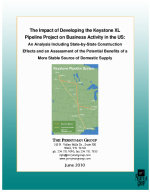The Impact of Developing the Keystone XL Pipeline Project on Business Activity in the US
An Analysis Including State‑by‑State Construction Effects and an Assessment of the Potential Benefits of a More Stable Source of Domestic Supply
Published on June 13, 2010

TransCanada Keystone Pipeline LP Ltd., proposed the Keystone Pipeline in February 2005, a $5.2 billion project to connect reliable oil supply regions in Canada with key US refining and distribution centers. In July 2008, TransCanada announced Keystone XL, an approximately $7 billion pipeline project that complements the original Keystone Pipeline and nearly doubles the size and capacity of the Keystone Pipeline System with an expansion to the US Gulf Coast. With Keystone XL, the Keystone Pipeline System would have the capacity to deliver approximately 1.1 million barrels of Canadian crude oil to US markets each day.
This initiative has significant implications for the US economy. In addition to the sizable economic stimulus generated by the construction and development of the pipeline, the more stable supply of oil will lead to other positive outcomes.
While "energy independence" is often discussed in domestic policy debates, it is highly unlikely that this objective can be attained in the foreseeable future. A more appropriate characterization of the US situation is the quest for "energy security," meaning a supply of oil in reliable quantities from more stable and predictable sources than the volatile regions which now dominate the global market. The availability of substantial Canadian supplies delivered in an efficient manner would bring notable economic benefits. A lower risk premium would generate cost savings and stimulate business activity. In effect, the Keystone XL Project facilitates a long-term increase in marginal supply, which will have a modest price effect permeating the entire economy. These benefits, of course, are over and above the sizable gains from the construction stimulus.
The Perryman Group measured the total impact of the construction and development of the proposed Keystone XL pipeline on the US economy. These effects over the life of the project were found to include $20.931 billion in total spending, $9.605 billion in output, and 118,935 person-years of employment. These benefits are significant in the states along the route, though spillover gains to other areas, particularly with regard to manufacturing, are quite notable.
For more details please refer to the full report.
- Tags: Keystone XL, oil, pipeline